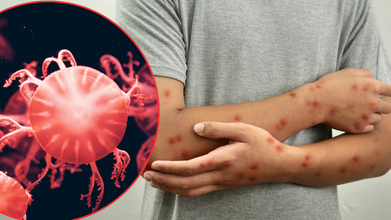- Health Conditions A-Z
- Health & Wellness
- Nutrition
- Fitness
- Health News
- Ayurveda
- Videos
- Medicine A-Z
- Parenting
- Web Stories
New COVID-19 Wave Hits Asia With Singapore And Hong Kong Reporting Sharp Rise In Cases

As much of the world moves into a new phase of pandemic-era life, COVID-19 itself continues to change, surprise, and endure. Over the past few weeks, Hong Kong and Singapore—two of Asia's most populous and globally connected cities—have seen a sudden spike in COVID-19 cases. The increase marks not only a local outbreak but a regional wave sweeping across Asia, reminding health authorities and global onlookers that the virus is an active and volatile force.
Hong Kong's Center for Health Protection has reported a significant increase in virus activity. Albert Au, director of the city's Communicable Disease Branch, said that the rate of respiratory samples that test positive for COVID-19 has reached a one-year high. Public health statistics indicated that severe cases, including deaths, have increased to 31 in the week through May 3—also a near-a-year high. Additionally, a troubling increase in COVID-related medical consultations, hospitalizations, and wastewater viral loads suggest widespread community transmission in the city of 7.4 million individuals.
On the other side of the South China Sea, Singapore is also confronted with the same situation. In its initial report of infection rates in almost a year, the health ministry of city-state reported a 28% rise in weekly cases to 14,200 for the week ending May 3. Hospitalization increased by about 30%, and that was the reason why the government issued an unusual public update, something it only usually does during serious outbreaks. In spite of the surge, Singapore's health officials insist there is no indication that the prevailing variants are more contagious or virulent than previous strains. Nevertheless, waning immunity and greater public mobility could be some of the factors.
What's The New COVID-19 Variant Spreading in 2025?
On a global level, the SARS-CoV-2 virus keeps mutating, and although the initial Omicron strain has vanished, its sublineages have taken over. Within the U.S., for example, LP.8.1 is the variant that today represents 70% of cases, followed by XFC (9%) and XEC (6%). Other Omicron descendant strains such as MC.1.10.1, LB.1.3.1, and LF.7 are also present.
It's worth noting that standard COVID-19 tests will not detect variants. Genomic sequencing alone can identify what particular strain caused a case of infection. These points of data are invaluable for surveillance by public health but are generally not shared at the individual level.
What makes this recent wave so significant is its timing. Historically, respiratory viruses have seasonality—spiking during colder seasons. But COVID-19 just won't follow that trend. The latest increase occurs as the Northern Hemisphere heads into summer, further solidifying COVID-19's transformation into an endemic virus with unpredictable seasonality. Health professionals warn that we can still expect waves of illness regardless of weather conditions.
Hong Kong and Singapore are not the only cities experiencing such a rebound. In mainland China, statistics from the Chinese Center for Disease Control and Prevention indicate that the nation is well on its way to achieving COVID levels comparable to last summer's peak. The hospital patient positivity rate more than doubled over a five-week period through May 4, a measure of widespread transmission.
Thailand, another tourist and cultural destination, has witnessed increases as well. Two cluster outbreaks have been identified in 2025, with a significant surge after the traditional Songkran festival in April, which attracts record crowds and travel.
Guidelines for Global Travel and Public Health
Although the current wave is less lethal than previous stages of the pandemic, it is a stark reminder that COVID-19 is far from being finished. Global air travel hubs such as Hong Kong and Singapore are gateways to the region and the world. An increase in cases there might presage more spread in other nations, especially once travel picks up again for summer vacations.
Concert cancellations—such as those of Hong Kong pop star Eason Chan in Taiwan—indicate the virus's disruptive power still exists. While hospitalizations have yet to achieve crisis levels, the strain on health systems and the economy is genuine and escalating.
How to Stay Protected And Vigilant?
As infections increase in various regions of Asia, public health officials are cautioning against complacency. Populations are strongly encouraged to stay vigilant. Booster shots are particularly recommended for high-risk individuals. Fundamental protective practices do not change: have good hand hygiene, host events outdoors, wear masks where public places are crowded, and stay home when you are unwell.
In the U.S., emergency room visits due to COVID decreased 19.5% during the latest reporting week, test positivity remained at 2.9%—below the 5% benchmark for uncontrolled community spread. Yet because most use at-home tests or don't test at all, official tallies probably underestimate actual prevalence.
The current COVID-19 wave sweeping across Hong Kong, Singapore, and the rest of Asia reminds us of a grim reality: the virus remains with us, even though our lives have mostly moved on. Although vaccines, better treatments, and public health interventions continue to offer robust protection, the virus's ability to surprise is still there. The world must keep evolving and responding to new waves, variants, and challenges in an ever-changing pandemic environment.
As the world begins to reopen and the danger recedes from view, it's obvious that COVID-19 has not left the stage—it's just changed costume.
Baek Se-hee, South Korean Author, Dies At 35, While Saving 5 Lives

Credits: Wikimedia Commons
South Korean author Baek See-he, who courageously chronicled her struggles with mental health in the bestselling memoir I Want to Die but I Want to Eat Tteokbokki, passed away at the age of 35. Her death was announced by the Korea Organ Donation Agency, which revealed that Baek donated her heart, lungs, liver, and kidneys, ultimately saving five lives.
While the exact cause of her death was not disclosed, Baek’s writing had already offered readers a deeply personal glimpse into her battles with depression and anxiety. Her 2018 memoir captures dialogues with her psychiatrist over twelve weeks, combined with reflective essays that explore the cycles of self-abuse and the challenges of living with a persistent depressive disorder. Following the success of her first book, Baek published a sequel in 2019, I Want to Die but I Still Want to Eat Tteokbokki, which delves into the ongoing journey of striving for contentment, highlighting her openness and vulnerability.
Baek’s Battle with Dysthymia
Baek openly discussed her long-standing struggle with dysthymia, a mild but persistent form of depression. According to the National Institutes of Mental Health, dysthymia affects roughly 2 percent of adults worldwide. The condition is believed to have a combination of biological, psychological, genetic, and environmental factors, although no specific genes have yet been linked to it. Chronic stress and trauma are also known contributors.
Symptoms of dysthymia are generally milder than major depression but are long-lasting. They often include a consistently sad or anxious mood, difficulty concentrating or making decisions, low energy, hopelessness, changes in appetite or weight, disturbed sleep patterns, and low self-esteem. Treatment typically involves a combination of medication and therapy. Antidepressants can take several weeks to show full effects, and cognitive behavioral or interpersonal therapy helps patients manage distorted thoughts, improve relationships, and navigate stress.
A Legacy Through Organ Donation
Baek’s passing was marked not only by sorrow but also by the profound impact of her organ donation. According to reports cited by The Guardian and The Telegraph India, her heart, lungs, liver, and both kidneys were recovered at the National Health Insurance Service Ilsan Hospital in Gyeonggi Province, north of Seoul—the same hospital where she was born. Baek was declared brain-dead on October 16, and her decision to donate her organs has given five people a chance at life.
Born in 1990, Baek studied creative writing at university before working for five years in a publishing house. She shared her home with her rescue dog, Jaram, and underwent psychiatric treatment for dysthymia for over a decade. The idea for her memoir grew out of her blog posts sharing therapy notes, which drew significant positive feedback from readers.
Her memoir, published in Korea in 2018 and in the UK in 2022 by Bloomsbury, combines candid discussions with her psychiatrist with reflective essays, presenting a clear-eyed yet compassionate look at living with a chronic mental health condition. Her follow-up book, released in the UK last year, continued this narrative, exploring her ongoing journey toward self-acceptance and emotional resilience.
Writing That Resonated Worldwide
Baek’s memoir, named after her favourite Korean dish, tteokbokki—a spicy rice cake dish—struck a chord with readers, selling around 600,000 copies in Korea and over a million worldwide. Her work has been published in more than 25 countries, offering a rare, unflinching insight into mental health while inspiring empathy and understanding.
A Severe Mpox Strain Is Spreading in the US, Here’s What You Need to Know to Stay Safe

Credits: Canva
Health officials in the United States have raised alarms after confirming cases of a more severe mpox strain, known as Clade I, in California. This marks the first reported instance of this strain spreading locally, as previous US cases had all been linked to international travel.
So far, three cases have been confirmed across Southern California, including Los Angeles County and Long Beach. All patients required hospitalization but are now recovering at home. The discovery has triggered concern among health experts as Clade I mpox is known to cause more serious illness than the milder Clade II strain that led to the 2022 global outbreak.
What Is Clade I Mpox?
Mpox (formerly called monkeypox) is caused by a virus from the same family as smallpox. There are two main genetic variants or clades that infect humans, Clade I and Clade II.
While Clade II was responsible for the global outbreak in 2022–23, Clade I has historically circulated in parts of central and western Africa. It is associated with more severe disease, higher rates of complications, and in some cases, fatalities, particularly among children, pregnant women, and people with weakened immune systems.
Experts are now investigating how this strain might have started circulating within US borders and whether community transmission is occurring.
Early Signs and Symptoms to Watch For
Mpox usually begins with flu-like symptoms and can be easily mistaken for a seasonal illness in its early stages. Common early signs include:
- Fever, chills, or sweating
- Headache and muscle aches
- Fatigue or weakness
- Swollen lymph nodes
- Sore throat or nasal congestion
Within a few days, a distinctive rash develops, starting as red spots that progress into fluid-filled blisters or pustules. These can appear on the face, palms, soles, genitals, or even inside the mouth and eyes. The rash typically scabs over and heals within two to four weeks.
In more severe Clade I infections, complications may include secondary bacterial infections, prolonged healing, scarring, eye involvement leading to blindness, or inflammation of internal organs. In rare cases, systemic infection can occur, posing life-threatening risks.
Who Is Most at Risk?
Certain groups are more likely to contract or develop severe mpox:
- Those in close, intimate, or prolonged contact with an infected person
- Individuals who share contaminated clothing, bedding, or surfaces
- People exposed to respiratory droplets through face-to-face interaction
- Individuals with multiple sexual partners or exposure in commercial sexual venues
- People with compromised immunity, such as those living with HIV, cancer, or transplant recipients
Children and pregnant women
Public health experts emphasize that awareness of symptoms and early diagnosis are key to preventing further spread.
How to Stay Safe
While most mpox cases are not fatal, Clade I poses a higher risk, making prevention critical. Health agencies recommend the following:
- Avoid direct contact with people who have rashes or lesions resembling mpox.
- Do not share personal items like towels, bedding, or clothing.
- Practice good hand hygiene, wash hands often with soap and water or use an alcohol-based sanitizer.
- Use masks in crowded or high-risk settings where close contact occurs.
- Seek medical attention immediately if you notice suspicious rashes or flu-like symptoms after possible exposure.
Experts also stress that vaccines used during the 2022 outbreak, such as Jynneos, remain effective against both Clade I and Clade II strains. Vaccination, combined with early treatment and isolation of confirmed cases, is expected to play a crucial role in containing the spread.
First Locally Acquired Clade 1 Mpox Case Detected California, Symptoms You Should Look Out For

(Credit-Canva)
The Long Beach Department of Health and Human Services has confirmed its first case of locally acquired Clade-1 Monkeypox strain. In a recent press release, the authorities informed the citizens that the person who was diagnosed had no recent travel history, which means the virus was contracted locally.
While the risk for the public remains low, the health department warns people to stay safe. Since it is a contagious disease, the health investigation is still ongoing, as the public officers comb through the person’s history. However, currently there are no other cases of the clade 1 mpox. Mayor Rex Richardson said, “While the overall risk of mpox clade I exposure to the public remains low, we are taking this very seriously and ensuring our community and health care partners remain vigilant so we can prevent any more cases.”
What Is Mpox?
According to the World Health Organization, Mpox (previously called monkeypox) is a sickness caused by a virus. Think of it as being like different types of flu—there are a few versions of the mpox virus, called clades.
The global outbreak that happened in 2022–2023 was caused by one of these versions, specifically Clade IIb. The virus spreads through close contact with an infected person's sores or body fluids, with contaminated items like bedding, or with infected animals. The virus can also be passed from a pregnant person to their baby.
Most mpox treatment involves supportive care—doctors help manage symptoms like pain and fever while the body recovers. This includes keeping the patient well-nourished and hydrated, caring for the rash, and addressing any secondary infections. Fortunately, vaccines are available for mpox.
How is Clade 1 Different From Clade 2?
This new case involves Clade 1 mpox, which is historically associated with more severe illness and is typically found in Central and East Africa.
In contrast, the large 2022-2023 outbreak in the U.S. and globally was caused by Clade 2, which usually results in milder illness. Mpox, regardless of the clade, spreads through direct contact with sores, body fluids, intimate contact, or contaminated items. Symptoms can include a rash or sores, fever, chills, sore throat, swollen lymph nodes, and body aches.
What Are The Health Risks of Mpox?
Long Beach health officials are currently investigating the patient's source of exposure and conducting contact tracing, though no other cases have been identified so far.
Long Beach Mayor Rex Richardson emphasized that while the overall risk to the public remains low, the city is taking the situation seriously. He stressed the importance of continued surveillance, early response, and vaccination.
A Long Beach public health physician, Dr. Cliff Okada, advised: "Anyone with an unexplained rash or lesions should seek care promptly. Speak openly with intimate partners and your healthcare provider. Early action protects you and others."
Who Is At Risk For Mpox Clade 1?
The Centers for Disease Control and Prevention (CDC) continues to recommend the Jynneos vaccine for people at high risk of exposure. This includes gay, bisexual, and other men who are intimately involved with other men, transgender and non-binary people, those with weakened immune systems (such as people with HIV), individuals exposed to an infected person, those with occupational exposure, and people traveling to areas with ongoing outbreaks.
Most mpox patients recover on their own within 2 to 4 weeks. A booster shot is not currently recommended for those who have completed the two-dose vaccine series.
© 2024 Bennett, Coleman & Company Limited

